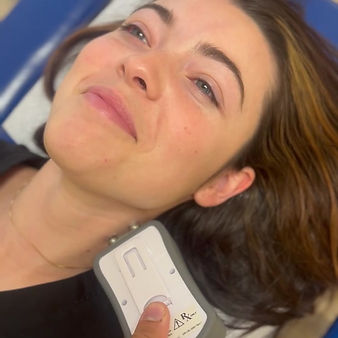
Vagal Nerve Stimulation
& Trigeminal Stimulation
Vagal Nerve Stimulation
Non-invasive vagal nerve stimulation (VNS) is a type of treatment that involves stimulating the vagus nerve without the need for surgery. The vagus nerve is a large nerve that runs from the brainstem to the abdomen and plays a role in controlling various functions in the body, including heart rate, digestion, and the immune system.
Non-invasive VNS typically involves the use of a device that delivers electrical stimulation to the vagus nerve through the skin. This is done with the use of an external device to stimulate the vagus nerve, rather than surgically implanting a stimulator as with traditional VNS. We use a handheld device that is placed on the neck, or through the use of an in the ear/earlobe. The device is programmed to deliver electrical pulses to the vagus nerve at regular intervals.
The Vagus nerve can inhibit inflammation, oxidative stress, and sympathetic activity (fight/flight response). The use of non-invasive VNS is often used to treat certain types of epilepsy, depression, headaches/migraines. It can also help stabilize other neurological conditions such as POTS or orthostatic hypotension. It is thought to work by altering the activity of certain chemicals in the brain, such as neurotransmitters, which can help to improve symptoms.

Trigeminal nerve stimulation is a form of neuromodulation that involves the use of a device to deliver electrical stimuli to the trigeminal nerve. This nerve is responsible for transmitting sensory information from the face, head, and mouth to the brain. Stimulating the trigeminal nerve has been shown to be effective in the treatment of a variety of conditions, including chronic pain, depression, and anxiety. TNS is often used to treat chronic pain conditions, such as trigeminal neuralgia, tension headaches, and temporomandibular joint disorder (TMJ).
Trigeminal nerve Stimulation has a significant impact on cerebral perfusion in both normal conditions and pathologic states. Increased cerebral blood flow is independent of systemic blood pressure, reducing cerebrovascular resistance.
1. Elevates brain tissue oxygenation
2. Prevents secondary injury from TBI
3. Reduces Facial pain, headaches/migraines
4. Prevents and reduces ischemia (lack of blood flow)
Trigeminal nerve stimulation has generally been found to be safe and well-tolerated, although it is not suitable for everyone and may not be effective in all cases. The procedure involves the use of a small device, called a stimulator, which is placed on the skin over the trigeminal nerve. The device sends a low-level electrical current through the skin to stimulate the nerve. TNS is typically administered on a daily basis, and the length of treatment may vary depending on the individual's response to the therapy. If you are interested in pursuing trigeminal nerve stimulation as a treatment option, it is important to discuss this with a qualified healthcare provider to determine whether it is appropriate for you and to receive proper guidance on its use.
_edited.png)


